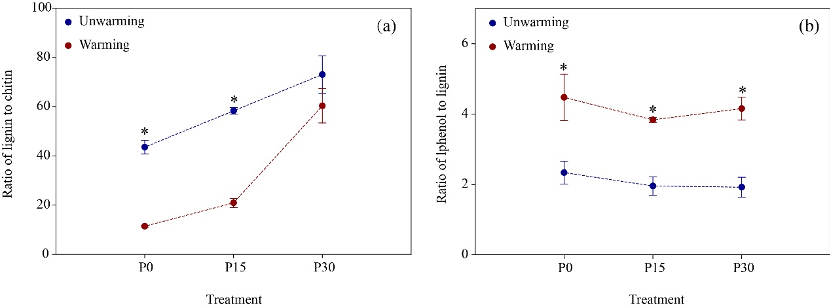Soils on the Tibetan Plateau are extremely sensitive to global climate change. They are young in terms of development,forming a thin, skeletal soil layer because the gravel parent materials are glaciofluvial deposit, eluvium, and fluvial sediment. The lack of understanding of soil organic matter (SOM) transformation processes in this region hinders the prediction of SOM stocks under future climate conditions. Recently, Prof. Gengxin Zhang’s group of Institute of Tibetan Plateau Research, Chinese Academy of Sciences studied the responses of the alpine SOM to global climate change, including Nitrogen (N) deposition, warming and increased precipitation, using pyrolysis‐gas chromatography/tandem‐mass spectrometry combined with microbial analysis methods.
Firstly, five typical alpine ecosystems on the Tibetan Plateau were selected for pre-test to explore which of soil fractions is the most sensitive to the external environment changes. The results showed that LF-SOM with density ≤2.25 g/cm3 was the most sensitive fraction. Based on the pre-test results, the artificial N additions, and warming and increased precipitation experiments were conducted to study the degradation stability of LF-SOM.
By a 2-yr multiple N addition (0, 10, 20, 40, 80, and 160 kg N ha-1 yr-1) experiment, it was found that N additions had significant effects on the content and composition of LF-SOM. There was a nonlinear response of LF-SOM to N addition levels, that is, the LF-SOM increased at the lowest N addition levels (10 and 20 kg N ha-1 yr-1) and decreased at higher N addition levels (40 to 160 kg N ha-1 yr-1), but the decrease of LF-SOM was weakened at 160 kg N ha-1 yr-1 addition (Fig. 1). Further study showed that the abundance of microbial functional genes, as one of the indicators of microbial activity, had significant positive correlations with LF-SOM (Fig. 2). At 10-20 kg N ha-1 yr-1, N additions significantly decreased microbial activity, while from 40to160 kg N ha-1 yr-1, microbial activity increased with N addition level increasing, which indicated that the disturbance of microbial activity caused by N additions was the main driver for the nonlinear response of LF-SOM to multilevel N additions.

Figure 1. Responses of the composition and content of LF-SOM to N additions.

Figure 2. Relationships between LF-SOM and microbial functional genes.
In addition, by a three-year field manipulation experiment with warming (+2 °C above ambient temperature) and increased precipitation (+15% and +30% above ambient precipitation) treatments, it was found that warming and increased precipitation indirectly affect LF-SOM turnover by directly affect the balance between vegetation input and microbial degradation. More specifically, increased precipitation promoted LF-SOM accumulation, which were mainly due to the positive effect of increased precipitation on vegetation productivity. In contrast, warming alone intensified the effect of drought on the alpine grassland, which had negative effects on both vegetation and microorganisms and reduced LF-SOM. Warming plus increased precipitation not only alleviated the water loss but also increased soil temperature, which was more favorable for the growth of microorganisms (Fig. 3 and Fig. 4).

Figure 3. Responses of LF-SOM to warming and increased precipitation.

Figure 4. Responses of organic compounds in LF-SOM to warming and increased precipitation.
Based on the above results, the researchers predict that, in the future, N deposition will inhibit the activity of microorganisms and contribute to the accumulation of LF-SOM. In contrast, microbial activity will increase as temperature increases, which will promote LF-SOM degradation only if precipitation also increases.
The above researches are published as “Comparison of soil organic matter transformation processes in different alpine ecosystems in the Qinghai-Tibet Plateau”, “Multilevel nitrogen additions alter chemical composition and turnover of the labile fraction soil organic matter via effects on vegetation and microorganisms” and “Warming and increased precipitation indirectly affect the composition and turnover of labile-fraction soil organic matter by directly affecting vegetation and microorganisms” on “Journal of Geophysical Research-Biogeosciences” (*2) and “Science of the Total Environment” (*1).
Article links:
https://doi.org/10.1016/j.scitotenv.2020.136787

